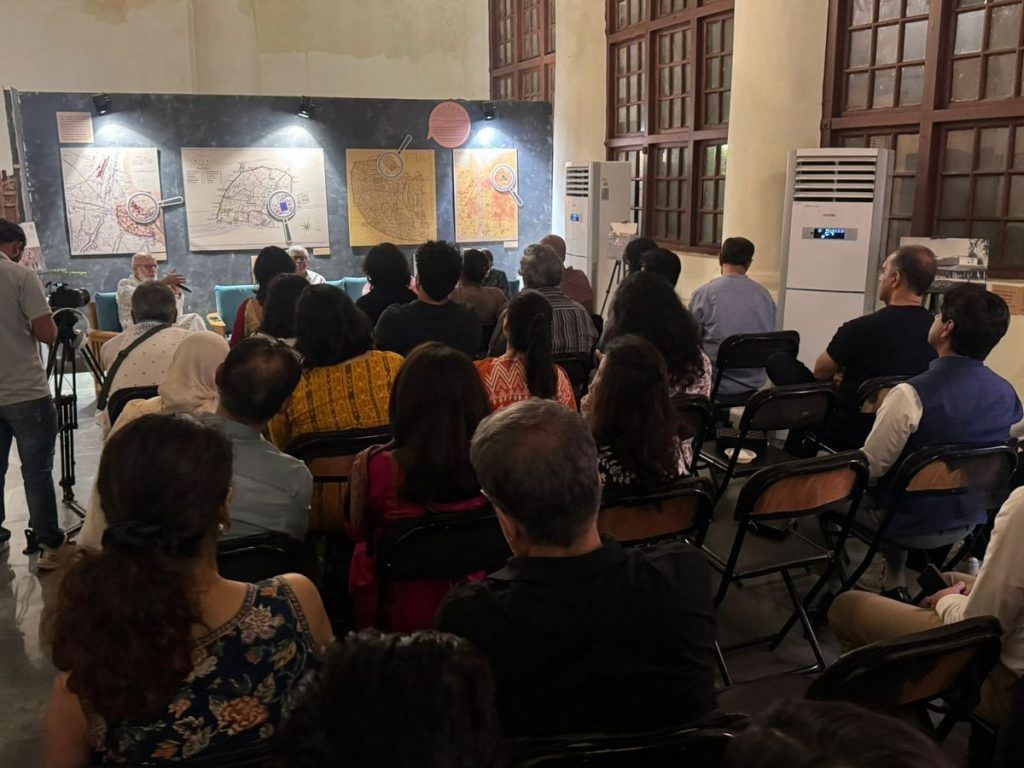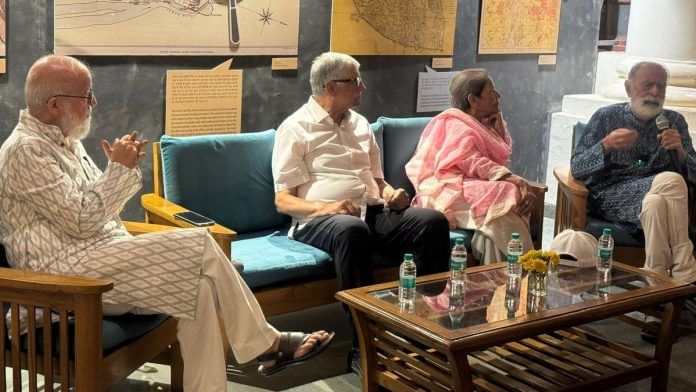Delhi: Long before Connaught Place became the heart of the national capital, the social and commercial hub of post-Partition Delhi was Kashmere Gate. In the 1950s, it was where Mughal-era history met modern-day glamour, and the fancy imported cars lined up on the streets spoke of that transformation.
“Back then, there was nothing in CP. Kashmere Gate was the first place where all [imported] cars were available in Delhi. Not just that, a polytechnic college and the only engineering college was in Kashmere gate,” recalled veteran actor Vinod Nagpal at Sarguzasht, an intimate gathering on 10 October organised by the urban heritage initiative Project Mohalla in collaboration with the Partition Museum and Dara Shukoh Library Cultural Hub in Delhi.
The topic for the evening was ‘Kashmere Gate – its memories, mohallas, and forgotten recipes’. Four friends — Nagpal, historian Sohail Hashmi, educationist Kamlesh Jacob, and veteran journalist Satish Jacob – gathered to travel through the lanes of history and nostalgia. Except for Hashmi, everyone had lived in and around Kashmere Gate. Their conversation flowed through its lanes and schools, Mithan’s dahi bhalla, and the old-world charm that once defined the neighbourhood. The discussion was followed by a six-course feast of Old Delhi delicacies made by the women of Home Chefs Collective.
Built by Mughal emperor Shah Jahan in the 17th century as part of his new capital Shahjahanabad, Kashmere Gate was one of 13 grand gateways, each leading to a different region or city, including Ajmer, Lahore, and Kabul.
Today, only four of these gates remain: Delhi Gate, Ajmeri Gate, Turkman Gate, and Kashmere Gate.
“Now, why is Kashmere Gate called Kashmere Gate? Because this road led to Kashmir. Kashmere Darwaza is outside the Delhi Darwaza. In the Kashmere Darwaza, there is a double arch instead of a single arch. And you can see that it is all brick wall,” said historian Sohail Hashmi.

Also Read: Delhi was an intellectual hub in ’90s. It felt like anything was possible: Artist Bharti Kher
A former education hub
As a child growing up in Kashmere Gate, Kamlesh Jacob studied at Queen Mary’s School. She recalled that the school was well-known and flourished in its time, with girls from all communities enrolling— Hindu, Muslim, Christian alike.
“All girls, cutting across religions, attended the school,” Jacob said.
She recounted her memories of the parda garden, a private space where Muslim girls would remove their burqas before entering the school premises.
“Muslim girls would come in a burqa, and there were Christian and Hindu students as well. It was a school respected by all parents who sent their daughters there,” recalled Jacob. “The school dated back to 1902.”
Jacob recalls that Kashmere Gate was once a major educational hub, home to the Delhi Engineering College, a polytechnic institute, and even the famous Hindu College, before they were eventually relocated.
Also Read: ‘Delhi’s declining sex ratio shows women’s fight is far from over,’ says Mrinal Pande
Cross-border dahi bhalla
Sohail Hashmi shared a story about Mithan and his famous dahi bhalla recipe. Hashmi’s grandmother carried it with her to Pakistan during Partition and brought it back years later, when she returned for the marriage of her son — Hashmi’s father.
During the wedding, with no money or jewellery to give, she gifted the recipe to her new daughter-in-law. It became a reminder of the world they had left behind.
Hashmi recalled how his grandmother would often tell the story of stopping by Mithan’s shop before leaving for Pakistan.
“My grandmother stopped by Mithan’s shop and told him, ‘We are leaving for Pakistan, but I will always remember your name.’ To which Mithan replied, ‘Then let me give you the recipe for the masala that made my bhallas so famous,’” Hashmi said, laughing.
Years later, when Hashmi’s mother retired as a teacher, she hosted a small farewell party for her colleagues. There, she served the same dahi bhalla, using Mithan’s masala recipe. A woman at the party approached her and asked about the recipe, saying how much she liked it. Hashmi’s mother shared the story.
According to Hashmi, the woman paused, then said, “I am Mithan’s daughter-in-law. I was wondering why the dahi bhalla tasted so familiar.”
A ripple of surprise went through the room, and everyone clapped spontaneously.
(Edited by Asavari Singh)






